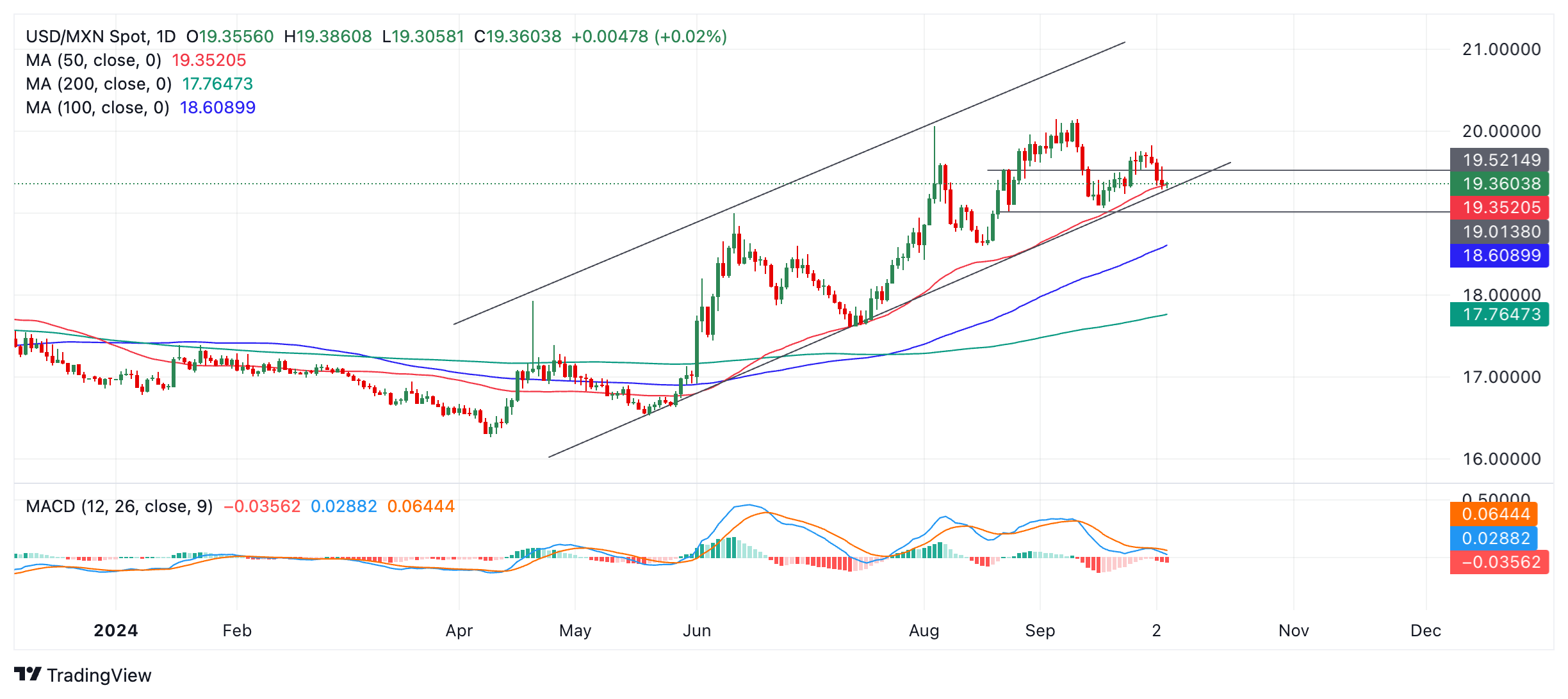- The Mexican Peso trades mixed after rising for four consecutive days.
- Gains came from a move by the Supreme Court to re-examine controversial reforms and a Banxico official’s comments.
- USD/MXN falls to critical support at the base of its rising channel and the 50-day SMA.
The Mexican Peso (MXN) fluctuates between minor gains and losses on Friday during the European session after clocking up four successive up days in all three of its most-traded pairs: USD/MXN, EUR/MXN, and GBP/MXN.
The Peso’s strength came initially from Deputy Governor of the Bank of Mexico (Banxico) Jonathan Heath, who commented on Tuesday that interest rates should remain higher for “more time”. Higher interest rates encourage more foreign capital inflows and strengthen the Peso. Later in the week, news of a Supreme Court decision to review and potentially revise controversial reforms to the judiciary encouraged a continuation of the rally.
It should be noted that the Peso is now at the 50-day Simple Moving Average (SMA) level in all of three of its key pairs, a technical indicator institutional investors take into account during their decision-making.
Mexican Peso appreciates following Supreme Court motion
The Peso rallied on Thursday after the news that Mexico's 11 Supreme Court judges voted by a majority of eight to three to re-examine controversial constitutional reforms to the judiciary, passed by the government in September. The move could block the implementation of the reforms, which seek to have judges elected rather than appointed, according to El Financiero.
Mexican financial markets took a beating in June after the election of the Morena-led government amid investor concerns regarding these and other proposed reforms. They were a contributing factor in a 10% depreciation of the Mexican Peso. Critics argue that they threatened the independence of the judiciary, were anti-democratic, and endangered outside investment.
The new laws, which were voted in by the Mexican Parliament in September, remain a risk to Mexican assets including the Peso, as highlighted by advisory service Capital Economics in a recent note:
“At the moment, Mexico has an investment grade rating from all three major rating agencies and we doubt this will change in the near-term,” wrote Kimberley Sperrfechter, Emerging Markets Economist at Capital Economics, adding, “That said, if the judicial reform leads to a significant deterioration in the quality of institutions and weaker growth and fiscal policy isn’t tightened sufficiently, there is a risk that Mexico is downgraded in the medium-term.”
The decision to have the reforms re-examined has been spear-headed by Supreme Court Judge Juan Luis González Alcántara. It rests on the legal principle that the new laws risk undermining the independence of Mexico’s judiciary.
Whilst the Supreme Court does not have the power to annul the laws, it can decide whether they need to be revised. Morena’s Head of the Government of Mexico City, Marti Luis Batres, described the move as a “coup d’etat”.
Technical Analysis: USD/MXN falls to 50-day Moving Average
USD/MXN falls all the way down to the base of its rising channel and the level of the 50-day Simple Moving Average (SMA) – a key line in the sand for traders.
USD/MXN Daily Chart
USD/MXN is expected to find support at this level, and there is a chance it will rebound and start moving higher within the range again. The medium and longer-term trends are now bullish, and given the technical analysis principle that “the trend is your friend,” the odds favor a recovery and continuation higher.
That said, the short-term trend is bearish, and the GBP/MXN cross has broken below its rising channel already, which can sometimes be a “canary in the coalmine” warning for other Peso pairs.
A decisive break below the channel and the 50-day SMA, therefore, risks threatening the medium-term uptrend in the USD/MXN. Such a move would be characterized by a longer-than-average bearish candlestick that pierced cleanly below both the channel line and the SMA, and closed near its low. Such a break would clear the way for losses, first down to 19.00 (August 23 low, round number) and then 18.60, the level of the 100-day SMA.
Banxico FAQs
The Bank of Mexico, also known as Banxico, is the country’s central bank. Its mission is to preserve the value of Mexico’s currency, the Mexican Peso (MXN), and to set the monetary policy. To this end, its main objective is to maintain low and stable inflation within target levels – at or close to its target of 3%, the midpoint in a tolerance band of between 2% and 4%.
The main tool of the Banxico to guide monetary policy is by setting interest rates. When inflation is above target, the bank will attempt to tame it by raising rates, making it more expensive for households and businesses to borrow money and thus cooling the economy. Higher interest rates are generally positive for the Mexican Peso (MXN) as they lead to higher yields, making the country a more attractive place for investors. On the contrary, lower interest rates tend to weaken MXN. The rate differential with the USD, or how the Banxico is expected to set interest rates compared with the US Federal Reserve (Fed), is a key factor.
Banxico meets eight times a year, and its monetary policy is greatly influenced by decisions of the US Federal Reserve (Fed). Therefore, the central bank’s decision-making committee usually gathers a week after the Fed. In doing so, Banxico reacts and sometimes anticipates monetary policy measures set by the Federal Reserve. For example, after the Covid-19 pandemic, before the Fed raised rates, Banxico did it first in an attempt to diminish the chances of a substantial depreciation of the Mexican Peso (MXN) and to prevent capital outflows that could destabilize the country.
Information on these pages contains forward-looking statements that involve risks and uncertainties. Markets and instruments profiled on this page are for informational purposes only and should not in any way come across as a recommendation to buy or sell in these assets. You should do your own thorough research before making any investment decisions. FXStreet does not in any way guarantee that this information is free from mistakes, errors, or material misstatements. It also does not guarantee that this information is of a timely nature. Investing in Open Markets involves a great deal of risk, including the loss of all or a portion of your investment, as well as emotional distress. All risks, losses and costs associated with investing, including total loss of principal, are your responsibility. The views and opinions expressed in this article are those of the authors and do not necessarily reflect the official policy or position of FXStreet nor its advertisers. The author will not be held responsible for information that is found at the end of links posted on this page.
If not otherwise explicitly mentioned in the body of the article, at the time of writing, the author has no position in any stock mentioned in this article and no business relationship with any company mentioned. The author has not received compensation for writing this article, other than from FXStreet.
FXStreet and the author do not provide personalized recommendations. The author makes no representations as to the accuracy, completeness, or suitability of this information. FXStreet and the author will not be liable for any errors, omissions or any losses, injuries or damages arising from this information and its display or use. Errors and omissions excepted.
The author and FXStreet are not registered investment advisors and nothing in this article is intended to be investment advice.
Recommended content
Editors’ Picks

How will US Dollar react to September Nonfarm Payrolls data? – LIVE
The US Bureau of Economic Analysis will release the September employment data, which will feature Nonfarm Payrolls and wage inflation figures. Investors will scrutinize the details of the report to see whether labor market conditions warrant another large rate cut.

EUR/USD stays defensive toward 1.1000, as US NFP data looms
EUR/USD stays defensive toward 1.1000 in the European session on Friday. The pair lacks a clear directional impetus, as traders refrain from placing fresh bets ahead of the key US Nonfarm Payrolls data. The focus remains on ECB-speak as well.

GBP/USD holds recovery above 1.3150 after BoE Pill's comments
GBP/USD holds recovery gains above 1.3150 in European trading on Friday. Prudent remarks from BoE Chief Economist Huw Pill on interest rates offer a fresh lift to the Pound Sterling. Further upside, however, appears elusive as caution prevails ahead of the US Nonfarm Payrolls data.

Gold price sticks to modest gains near weekly top, bulls seem non-committed ahead of US NFP
Gold price (XAU/USD) struggles to capitalize on its modest intraday uptick and remains below the weekly top through the early part of the European session on Friday.

RBA widely expected to keep key interest rate unchanged amid persisting price pressures
The Reserve Bank of Australia is likely to continue bucking the trend adopted by major central banks of the dovish policy pivot, opting to maintain the policy for the seventh consecutive meeting on Tuesday.

Five best Forex brokers in 2024
VERIFIED Choosing the best Forex broker in 2024 requires careful consideration of certain essential factors. With the wide array of options available, it is crucial to find a broker that aligns with your trading style, experience level, and financial goals.
